

THE JOKER'S WILD


Front Game Rules (1972-86 versions) | ||
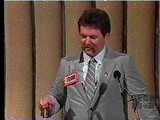
| Two players competed. Beginning with the challenger, players alternated setting a slot machine in motion, each window containing five categories and Jokers. The player then selected a question as available on the machine. Picking a question with only one of its symbols showing was worth $50, a pair was wor th $100, and a triple was worth $200. Jokers were wild and could be used to represent any category they wanted (including one that wasn't shown; this action was known as going "off the board".) If a player answered incorrectly, his/her opponent could answer the question and steal the money. | 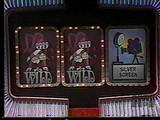
|
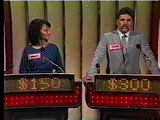
| The first player to reach $500 won the game, although both players got an equal number of chances at the Joker machine (meaning if the challenger reached $500 first, the champion had one more chance to meet or beat that total). If a player spun three Jokers, s/he could win the game immediately by answering one question from any category. From 1980-81, a children's version of the show was produced, entitled "Joker! Joker! Joker!" The rules were identical, only that the children played for points. | |
Front Game Rules (1990-1 version) | ||
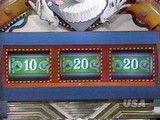
| The '90s version of the game began with three players. A toss-up question was asked, and the player who buzzes in first and answers correctly gets control of the Joker machine. This time, the windows had money, which was the value of each right answer. The third window on the machine could also show a Joker, which tripled the dollar value of right answers for 15 seconds. Host Finn would give the player a person, place or thing, and the player had to identify it. Upon an incorrect answer, the other two players could buzz in for control. The first player to reach $500 advanced to the second round with the second place player. | 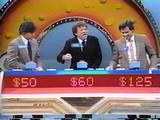
|
In the second round, the definitions were organized into categories. Also, the third window could show "Opponent's Choice," in which the other player could choose the category that contestant played. The first player to win $2000 won the game. | ||
| Later on during the run, the format was tweaked to incorporate elements of the original show. In this version, the Joker machine had categories and Jokers on all three windows. Single appearances were worth $25 for each right answer, $50 for a pair, and $100 for a triple. If three Jokers appeared, the player won $250 and got to choose from three categories for $100 an answer. | 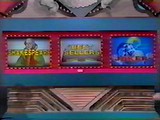
| |
End Game Rules (1972-86 versions) - "Face the Devil" | ||
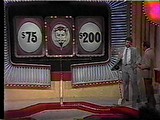
| On the Joker machine now were amounts of money from $25 to $200 as well as Devils. The player spun the wheels, and the player could stop with the money accumulated at any time. If the Devil showed up, the player lost all the money built up in the bonus round; if the player could amass $1000 or spin a Natural Triple (no Jokers) before hitting a Devil, the player won the money and a bonus prize package. | |
End Game Rules (1990-1 version) | ||
| The '90 bonus round was played in two parts. In the first stage, the host read up to three definitions of a word (all words started with the same letter). Each word identified in 60 seconds earned a spin on the Joker machine, which now bore prizes. After each spin, the player could freeze any windows s/he wanted in an attempt to match the same prize on all three windows, at which point s/he won that prize. If the player spun three Jokers (only possible on the first spin), s/he won a cash jackpot that started at $5000 and increased by $500 each day it wasn't won. | 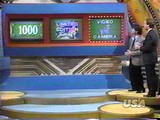
| |
The Joker's Wild was the first major sale made by Jack Barry since the quiz show scandals in 1958. A pilot had been shot in 1969 with a much different format, hosted by Allen Ludden.
During the early to mid '80s, three audience members were called up at the end of the show to play a game with the Joker machine. Each got a spin at the machine and won however much money was on the wheels. The player who scored the highest got to Face the Devil for another $1000 and a bonus prize. When Bill Cullen took the helm, this became a home viewer game.
This turned out to be the last game show hosted by three of its emcees; Jack Barry died in 1984 due to a heart attack, and was replaced by Bill Cullen. Cullen hosted the show until its cancellation in 1986, and died in 1990 from lung cancer. Jim Peck, who substituted for Barry at certain points during the run, went on to become the court reporter for the '80s "Divorce Court," but has not hosted a game show since TJW. He currently works at Marquette University in Milwaukee, Wisconsin. And we all wish this had been Pat Finn's last show.
What a way to redeem yourself. The game was quite fun to watch; granted, the questions were often gaggingly easy, but watching the slot machine in motion always added some excitement. Jack Barry had a knack for anticipating three Jokers when two were showing. Sadly, this being Bill Cullen's last show, you could see he hosting ability starting to slip. Also, this was a more fast-paced game; Cullen is a lot more slow and methodical. Plus, the endgame started a trend that would continue throughout most B&E games: No skill, no strategy, just rack up enough money before hitting the bad guy.
When the show returned in 1990, we learned firsthand what happens when someone screws around with an established format. The game was much more slow-paced, and although I prefer the matching-prizes bonus round to Face the Devil, the first part with Pat Finn droning "First definition... last definition" over and over really got boring. I won't go as far as saying that Finn's hosting job was completely abysmal, but certainly it's not the best work I've seen.
Gameplay: 2 pts.
Host: 3 pts.
Presentation: 1 pt.
Execution: 2 pts.
Total Score: 8 pts.
Gameplay: 2 pts.
Host: 3 pts. (Barry), 2 pts. (Cullen)
Presentation: 2 pts.
Execution: 2 pts.
Total Score: 9 pts.
Gameplay: 1 pt.
Host: 1 pt.
Presentation: 1 pt.
Execution: 0 pts.
Total Score: 3 pts.